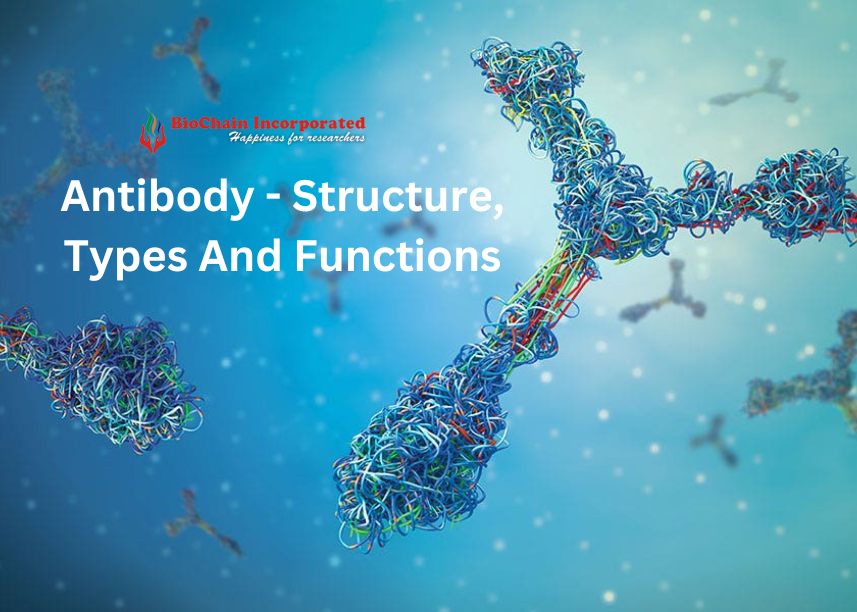Antibody - Structure, Types And Functions
Antibodies, also known as immunoglobulins (Ig), are proteins that play an important role in the immune system by identifying and eliminating foreign substances such as bacteria, viruses and toxins. These Y-shaped molecules are produced by B cells and are important for the body's defense against infections. This blog explores the structure of antibodies, their different types and their functions.
Antibody structure
Antibodies have a complex structure that allows them to recognize and bind to specific antigens (foreign substances). The basic structure of an antibody consists of four polypeptide chains: two identical heavy chains and two light chains connected by disulfide bonds. For the best antibodies, connect with Biochain, one of the best custom antibody suppliers in India.
- Heavy chains: These are long polypeptide chains. They are the main structure of the antibody and determine its class or type.
- Light chains: These short chains help in antigen-binding.
- Surface region (fragment, antigen binding): the Y-shaped arms of the antibody that bind to the antigen. This region is so diverse that antibodies can recognize millions of different antigens.
- Fc domain (fragment, crystal): The Y-shaped antibody stem is responsible for interacting with immune cells and mediating various immune responses.
Types of Antibodies
There are five main classes of antibodies, each with a specific function:
IgG (Immunoglobulin G):
- Structure: Monomer
- Function: The most general antibody in the blood, IgG is important to fight bacterial and viral infections. It can cross the placenta and create an immune system for babies.
- Main function: Prevention and long-term memory after infection or injection.
IgA (Immunoglobulin A):
- Structure: dimer (in secretions) and monomer (in blood)
- Function: found in mucosal sites such as the respiratory tract and mining. It is also found in body fluids such as saliva, tears and breast milk.
- The main function: Protects the mucosal surfaces and is important for the safety of infants through breastfeeding.
IgM (Immunoglobulin M):
- Structure: Pentamer
- Function: First antibody produced in response to infection. It is found mostly in the blood and lymph fluid.
- Main Function: Provides the first line of defense at the onset of disease. IgE (immunoglobulin E): Structure: Monomer Function: Plays an important role in allergic reactions. When bound to allergens, histamine is released from mast cells and basophils.
- Main role: Contributes to the protection of parasitic diseases and allergic reactions.
IgD (immunoglobulin D):
- Structure: Monomer
- Function: Found on the surface of mature B cells as a receptor for antigens.
- The main function: B markers are activated in response to pathogens, although the exact function is not fully understood. Role of Antibodies Antibodies play many important roles in the immune response.
Here are their main functions:
- Neutralization: Antibodies can neutralize pathogens by binding directly to them, preventing them from entering or damaging cells. This is very important for diseases.
- Relationship: When antibodies bind to a pathogen, they increase its recognition by immune cells such as macrophages, making it easier to capture and destroy the pathogen.
- Activation of the complement system: Antibodies can activate the complement system, a group of proteins that help destroy pathogens through cell lysis and phagocytosis.
- Antibody-mediated rejection (ADCC): In ADCC, antibodies bind to infected cells or tumor cells, signaling them to be destroyed by natural killer cells .
- Agglutination: Antibodies can bind to certain antigens and agglutinate. This activity helps to prevent pathogens and makes the immune system work more easily.
Antibodies are key mediators of the immune system, and each type has a specific role in identifying, neutralizing and eliminating pathogens. Biochain has become one of the leading antibody suppliers in India. Their ability to adapt and remember foreign predators is important to them for immediate and long-term survival. Understanding the structure, types and function of antibodies provides a better understanding of how the body fights disease and why it is important to the development of vaccines and medicines. Contact now.



.png)

.png)


.png)
.png)
.png)
.png)
.png)